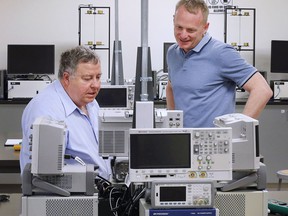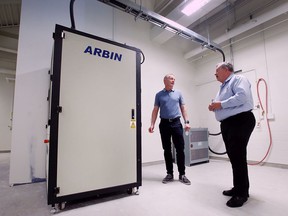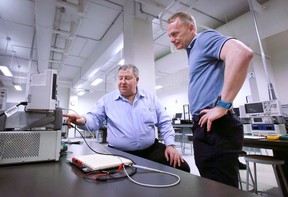
Article content
While two new electrified platforms and the return of the third shift at Windsor Assembly Plant grabbed the headlines Monday, leaders in the automotive sector say Stellantis’s decision to create a local battery research and development lab will put the city on the “world stage” of electric vehicle development.
advertisement 2
Article content
A 100,000-square-foot electric battery lab will be added to the company’s Automotive Research and Development Center (ARDC) in Windsor and 650 engineers will be hired.
The ARDC, which previously had a wide mandate of testing various parts of vehicles, will now focus on electrified propulsion systems, including batteries, power electronics, electric machines, motor controls, energy management and embedded software.
The new battery lab will be tasked with developing and testing battery electric, plug-in hybrid and hybrid cells, modules and packs.
The new research facility is expected to be operational by the end of 2023.
“It further cements that Windsor is going to be the battery capital of Canada and probably North America,” Automotive Parts Manufacturers’ Association president Flavio Volpe said.
advertisement 3
Article content
“That’s a signal going forward for anyone wondering if Windsor is going to continue to be a core manufacturing center for this company or an intelligence center. That’s the part for me, like the 1,000-engineer investment by General Motors in Oshawa for connected and autonomous vehicles, that says Canada is back.”
The lab will be the first of its kind for Stellantis in North America. It follows the company’s previous announcement to build a similar lab in Turin, Italy.
Last month, Stellantis announced a partnership with LG Energy Solutions to build a $5-billion battery plant in Windsor, the firm’s first in North America, making the central region to the company’s plans to have electric vehicles represent 53 per cent of its new vehicle sales by 2030.
advertisement 4
Article content
“This will be our hub for battery tech development,” said Mark Stewart, Stellantis’s chief operating officer for North America.
“It’ll be primarily software and electrical engineers that we’ll be bringing onboard,” he said. “My plan is to add some of those engineers into Brampton and Windsor as well so we can pull from those talent pools as well.”
Until now, said Volpe, much of the research and development around batteries has taken place in Asia. The Stellantis investments open a new front of competition in the race to create smaller, higher density batteries.
“That work is going to be done here, the questions are going to be asked here,” Volpe said.
“Other companies are going to hear we have the technical expertise locally to test and develop in that very specific space where every company in the world is in an absolutely heated competition.
advertisement 5
Article content
“This is that missing piece. Everything changes when you start building that capacity locally.”
Stewart added the company plans to build on an already strong collaboration with local post-secondary institutions and to explore reaching down to the high-school level.

The ARDC, which has been a partnership with the University of Windsor since its founding in 1996, has seen over a billion dollars in investment and upgrades since its creation. Virtually every Stellantis/Chrysler model built for the North American market since then has been put through the rigors of the Windsor testing and research facility.
“It’s not hard to see where the center of gravity is in the Canadian auto industry — it’s here,” said Peter Frise, director of the University of Windsor’s Center for Automotive Research and Education.
advertisement 6
Article content
“We weren’t entitled to anything. We had to earn it and we’ve done that.”
Frise said Stellantis anchoring its battery research in Windsor will be transformational. The battery lab and battery production plant, combined with existing assets like the university’s Charge Lab and SHIELD Automotive Cybersecurity Center of Excellence, will be magnets for companies operating in the electric vehicle space.
It’ll put us very much on the world stage
“I think it’ll be bigger than that,” said Frise, when presented with the comparison of the impact Blackberry had in growing Kitchener-Waterloo’s tech sector.
“The automotive sector is much bigger than the telecommunications industry. “This is already an ecosystem that knows how to innovate. It’s why Chrysler chose to locate the ARDC here 25 years ago.”
advertisement 7
Article content
Frize said there’s “a lot happening already under the surface” between the university and Stellantis. The battery lab will only deepen the relationship.
“It’ll put us very much on the world stage in this kind of work,” Frise said. “We’re only at the beginning of the work to be done in developing electric powertrains.”
-
Stellantis announces $3.6B investment in Windsor, Brampton plants
-
$5B Windsor battery plant the largest private sector investment in Ontario history
-
Windsor’s post-secondary institutions preparing for industry needs for new battery plant
Peter Wawrow, St. Clair College’s director of research and development, said the revamped ARDC will provide opportunities for students and jobs for graduates who wish to stay in the area.
advertisement 8
Article content
With the college increasingly offering programs in the electric vehicle and battery space, Wawrow said St. Clair could pivot quickly to produce the talent Stellantis needs once it learns the details of the research to be done.
“This investment definitely changes the landscape,” Wawrow said. “People ask if this is diversifying our economy and the answer is yes.
“This will bring in people with different skill sets to the region. We’ll have to train students for different types of jobs.
“This is all cutting-edge technology and to have the hub here is huge.”
More news, fewer ads: The Windsor Star’s in-depth journalism is possible thanks to the support of our subscribers. More news, fewer ads, faster load times for just $3.50 per week – and unlimited access to The Ottawa Citizen, The London Free Press, National Post and 13 other Canadian news sites. Support us by subscribing today WindsorStar.com



